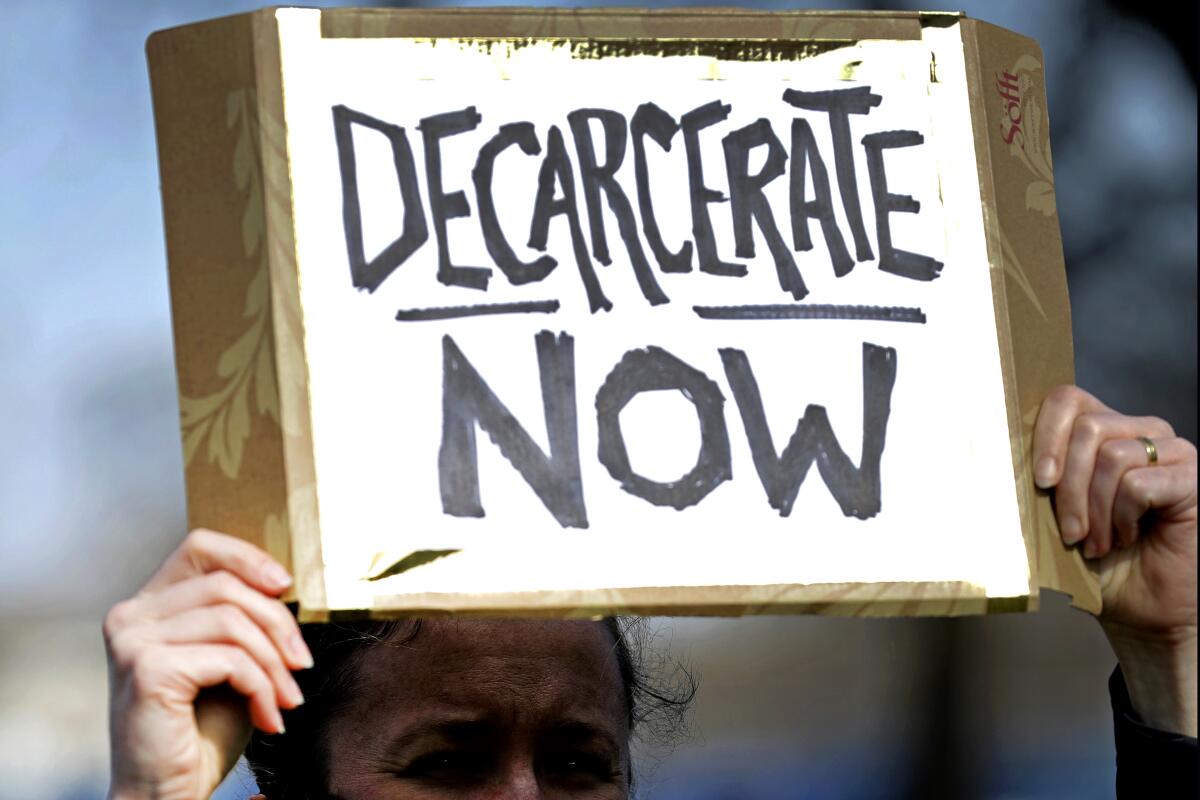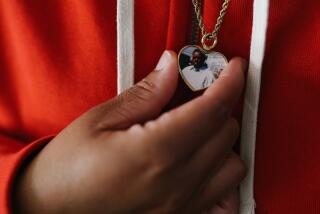Op-Ed: I’m keeping San Francisco safer by emptying the jail. My father should be freed too

- Share via
I am the district attorney in San Francisco, and my job is to keep the public safe. In mid-March, I started emptying out our city and county jail because those living and working there face a grave risk of falling ill, dying and spreading COVID-19. My sense of urgency about this issue is professional, and it’s also personal: My 75-year-old father lives in a prison cell.
When I was a little over a year old, my parents, both political activists, made the terrible decision to act as getaway drivers in a botched robbery meant to raise money for their cause. Though my mother and father were unarmed, other participants shot and killed two police officers and a security guard. My mother pleaded guilty to felony murder, served 22 years and was released. My father, without a lawyer, was sentenced to 75 years to life.
For the record:
4:19 p.m. May 6, 2020An earlier version of this piece said the year to year crime rate in San Francisco had fallen through May. It has fallen through April.
My parents’ decisions caused irreparable, cascading harm, but 38 years later, they shouldn’t mean that my father, a model prisoner with numerous underlying medical conditions, is sentenced again, this time to die prematurely from a viral outbreak.
According to the Prison Policy Initiative, almost 2.3 million people are incarcerated in this country. In jails, prisons, juvenile halls and immigration detention centers, they are trapped in close quarters in no way designed to shield them from a deadly virus. Social distancing in densely populated cell blocks is impossible. Jail and prison inmates lack basic hygiene items, like sanitizer and masks. The daily churn of detainees and staff creates tremendous risk of an epidemic within the pandemic.
Chicago’s Cook County Jail is one of the biggest single COVID-19 hot spots in the nation. More than 900 cases are traceable to the jail; many involve staff, not inmates. In my father’s New York prison, the person in the cell next to him was just evacuated with COVID-19. Across the New York prison system, 1,026 prison staff and 3,30 incarcerated people have been COVID-19-confirmed; given limited testing, the true number is surely much higher.
In San Francisco, I make decisions with my colleagues about who to incarcerate for how long and who to release on what conditions. These decisions are often agonizing, nearly impossible balancing acts of competing risks. For decades, criminal justice policy has been driven by the sometimes realistic fear that any person released could commit a heinous crime. But data show that allowing such fears to override all other concerns is shortsighted. Locking up millions of people destroys families and communities; bankrupts local governments; tends to increase, not decrease, crime rates; and too often provides only cold comfort to victims. The pandemic is further evidence that mass incarceration can be a threat, not a boon, to public safety.
My office is determined to allow public health officials to guide public policy through the coronavirus crisis. Using the discretion granted to prosecutors by law, we’ve reduced San Francisco’s jail population by 40% since March 16, the date of the city’s shelter-in-place order. Our year-to-year data show that through April, the city and county crime rate has fallen.
When public safety allows, we delay filing new charges. We have released, pending trial, those in jail facing low-level offenses, along with the elderly and medically vulnerable. We work with the courts to expedite scheduled releases for inmates with solid reentry plans. We avoid detaining people for technical violations such as missed appointments.
Through this work, we’ve identified some people who should never have been in jail in the first place, and we’ve found more humane, cost-effective, safer alternatives instead. For example, one woman with a high-risk pregnancy and no criminal history was in jail on misdemeanor charges. With our reentry partners, we deemed her jail time served adequate for the offense and released her into a prenatal care facility. With other city agencies, we are helping to provide furnished apartments for domestic violence victims. We are calling for more resources for those being released to ensure they can succeed and aren’t rearrested.
Although many prosecutors and local law enforcement officials across the country are also using their discretion to decrease their jail populations, more need to embrace reforms in the face of this pandemic. Data show the way. State prisons, for example, where there are far more people incarcerated than at the local level, could release most inmates over the age of 65 who have already served 10 or more years, a significant sentence. Continuing their incarceration is expensive, they are at high risk for serious infection, and their recidivism rate is just 4%.
Balancing the risks and costs of incarceration versus release isn’t just about keeping incarcerated people safe; it is about our mutual survival. Half a million guards, plus nurses, lawyers, vendors, deputies and chaplains move in and out of jails and prisons every day; they go home to their families and communities at night. If we ignore the spread of COVID-19 behind bars, we endanger those on the outside as well.
I will continue to protect the safety of all San Franciscans — residents, crime victims, public servants and those who live and work in our jails. Though I know my efforts can’t protect my own father, I hope they will save someone else’s.
Chesa Boudin is the district attorney of San Francisco.
More to Read
A cure for the common opinion
Get thought-provoking perspectives with our weekly newsletter.
You may occasionally receive promotional content from the Los Angeles Times.










